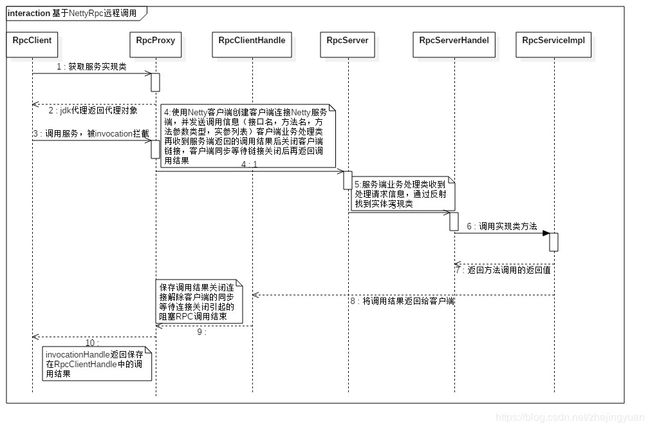基于Netty手写的Rpc框架
基于Netty手写的rpc框架时序图
本项目一共分为三个模块:rpcServer、rpcClient、rpcCommon
rpcCommon的依赖
io.netty netty-all 5.0.0.Alpha2 org.reflections reflections 0.9.11
rpcServer、rpcClient的依赖
rpc rpc-common 1.0-SNAPSHOT
rpcCommon目录结构
rpcCommon--ClassInfo类
package com.hk.common;
import java.io.Serializable;
/**
* 使用JDK的序列化技术必须实现接口Serializable
*/
public class ClassInfo implements Serializable {
private int id;
private String className;
private String methodName;
private Class[] parameterTypes;
private Object [] paramters;
public int getId() {
return id;
}
public void setId(int id) {
this.id = id;
}
public String getClassName() {
return className;
}
public void setClassName(String className) {
this.className = className;
}
public String getMethodName() {
return methodName;
}
public void setMethodName(String methodName) {
this.methodName = methodName;
}
public Class[] getParameterTypes() {
return parameterTypes;
}
public void setParameterTypes(Class[] parameterTypes) {
this.parameterTypes = parameterTypes;
}
public Object[] getParamters() {
return paramters;
}
public void setParamters(Object[] paramters) {
this.paramters = paramters;
}
}
接口
有参接口
package com.hk.common;
public interface HasArgsHelloService {
String hello(String msg);
}
无参接口
package com.hk.common;
public interface NoArgsHelloService {
String hello();
}
rpcServer目录结构
rpc服务端代码
//利用netty创建服务ServerBootstrap,粘合两个NioEventLoopGroup,配置端口ip,设置编码解码信息
package com.hk.rpc.server;
import com.hk.rpc.server_stub.RpcServerHandler;
import io.netty.bootstrap.ServerBootstrap;
import io.netty.channel.ChannelFuture;
import io.netty.channel.ChannelInitializer;
import io.netty.channel.ChannelOption;
import io.netty.channel.nio.NioEventLoopGroup;
import io.netty.channel.socket.SocketChannel;
import io.netty.channel.socket.nio.NioServerSocketChannel;
import io.netty.handler.codec.serialization.ClassResolvers;
import io.netty.handler.codec.serialization.ObjectDecoder;
import io.netty.handler.codec.serialization.ObjectEncoder;
public class RpcServer {
public static void main(String[] args) {
RpcServer.start("127.0.0.1", 9999);
}
public static void start(String ip, Integer port) {
//创建boss线程组(有点像负责招人的包工头)
NioEventLoopGroup boss = new NioEventLoopGroup();
//创建建立链接的线程
NioEventLoopGroup worker = new NioEventLoopGroup();
ServerBootstrap bootstrap = new ServerBootstrap();
try {
bootstrap.group(boss, worker)
.channel(NioServerSocketChannel.class)
.option(ChannelOption.SO_BACKLOG, 128)
.childHandler(new ChannelInitializer() {
@Override
protected void initChannel(SocketChannel ch) throws Exception {
ch.pipeline().addLast(new ObjectEncoder());
ch.pipeline().addLast(new ObjectDecoder(1024 * 64, ClassResolvers.cacheDisabled(null)));
ch.pipeline().addLast(new RpcServerHandler());
}
});
//bind初始化端口是异步的,但调用sync则会同步阻塞等待端口绑定成功
ChannelFuture future = bootstrap.bind(ip, port).sync();
System.out.println(ip + ":服务已启动,端口为:" + port);
future.channel().closeFuture().sync();
} catch (Exception e) {
e.printStackTrace();
} finally {
boss.shutdownGracefully();
worker.shutdownGracefully();
}
}
}
服务端处理器代码
//真正通过反射找到实现类,调用方法返回结果
package com.hk.rpc.server_stub;
import com.hk.common.ClassInfo;
import io.netty.channel.ChannelHandlerAdapter;
import io.netty.channel.ChannelHandlerContext;
import java.lang.reflect.Method;
import java.util.Set;
import org.reflections.Reflections;
public class RpcServerHandler extends ChannelHandlerAdapter {
@Override
public void channelRead(ChannelHandlerContext ctx, Object msg) throws Exception {
//获取调用信息,寻找服务实现类
ClassInfo classInfo = (ClassInfo) msg;
String implName = getImplClassName(classInfo.getClassName());
Class clazz = Class.forName(implName);
Method method = clazz.getMethod(classInfo.getMethodName(), classInfo.getParameterTypes());
Object result = method.invoke(clazz.newInstance(), classInfo.getParamters());
ctx.writeAndFlush(result);
}
private String getImplClassName(String interfaceName) throws ClassNotFoundException {
Class interClass = Class.forName(interfaceName);
String servicePath = "com.hk.rpc.service";
Reflections reflections = new Reflections(servicePath);
Set
if (implClasses.isEmpty()) {
System.err.println("impl class is not found!");
} else if (implClasses.size() > 1) {
System.err.println("there are many impl classes, not sure invoke which");
} else {
Class[] classes = implClasses.toArray(new Class[1]);
return classes[0].getName();
}
return null;
}
}
两个实现类代码
package com.hk.rpc.service;
import com.hk.common.HasArgsHelloService;
public class HasArgsHelloServiceImpl implements HasArgsHelloService {
public String hello(String msg) {
return "hello "+msg;
}
}
package com.hk.rpc.service;
import com.hk.common.NoArgsHelloService;
public class NoArgsHelloServiceImpl implements NoArgsHelloService {
public String hello() {
return "hello";
}
}
项目结构:rpcClient
客户端代码
//利用代理类来测试流程
package com.hk.rpc.server;
import com.hk.common.HasArgsHelloService;
import com.hk.common.NoArgsHelloService;
import com.hk.rpc.client_stub.RpcProxy;
public class RPCClient {
public static void main(String[] args){
NoArgsHelloService noArgsHelloService = (NoArgsHelloService) RpcProxy.create(NoArgsHelloService.class);
System.out.println(noArgsHelloService.hello());
HasArgsHelloService hasArgsHelloService = (HasArgsHelloService) RpcProxy.create(HasArgsHelloService.class);
System.out.println(hasArgsHelloService.hello("hello 黄凯!"));
}
}
客户端处理器代码
//接收到服务端的请求,并赋值以及关闭连接
package com.hk.rpc.client_stub;
import io.netty.channel.ChannelHandlerAdapter;
import io.netty.channel.ChannelHandlerContext;
public class RpcClientHandler extends ChannelHandlerAdapter {
/**
* RPC调用返回的结果
*/
private Object rpcResult;
public Object getRpcResult() {
return rpcResult;
}
public void setRpcResult(Object rpcResult) {
this.rpcResult = rpcResult;
}
@Override
public void channelRead(ChannelHandlerContext ctx, Object msg) throws Exception {
setRpcResult(msg);
ctx.close();
}
}
客户端代码类
//根据接口类信息通过jdk代理来调用实现类,在Bootstrap建立连接后,添加客户端处理器,并返回信息
package com.hk.rpc.client_stub;
import com.hk.common.ClassInfo;
import io.netty.bootstrap.Bootstrap;
import io.netty.channel.ChannelFuture;
import io.netty.channel.ChannelInitializer;
import io.netty.channel.ChannelOption;
import io.netty.channel.nio.NioEventLoopGroup;
import io.netty.channel.socket.SocketChannel;
import io.netty.channel.socket.nio.NioSocketChannel;
import io.netty.handler.codec.serialization.ClassResolvers;
import io.netty.handler.codec.serialization.ObjectDecoder;
import io.netty.handler.codec.serialization.ObjectEncoder;
import java.lang.reflect.InvocationHandler;
import java.lang.reflect.Method;
import java.lang.reflect.Proxy;
public class RpcProxy {
public static Object create(final Class clazz) {
return Proxy.newProxyInstance(clazz.getClassLoader(), new Class[]{clazz}, new InvocationHandler() {
public Object invoke(Object proxy, Method method, Object[] args) throws Throwable {
//构造调用信息
ClassInfo classInfo = new ClassInfo();
classInfo.setClassName(clazz.getName());
classInfo.setMethodName(method.getName());
classInfo.setParameterTypes(method.getParameterTypes());
classInfo.setParamters(args);
//使用netty发送调用信息给服务提供方
NioEventLoopGroup group = new NioEventLoopGroup();
//
Bootstrap bootstrap = new Bootstrap();
final RpcClientHandler rpcClientHandler = new RpcClientHandler();
try {
bootstrap.group(group)
.channel(NioSocketChannel.class)
.option(ChannelOption.SO_KEEPALIVE, true)
.option(ChannelOption.TCP_NODELAY, true)
.handler(new ChannelInitializer() {
@Override
protected void initChannel(SocketChannel ch) throws Exception {
ch.pipeline().addLast(new ObjectEncoder());
//反序列化对象时指定类解析器,null表示使用默认的类加载器
ch.pipeline().addLast(new ObjectDecoder(1024 * 64, ClassResolvers.cacheDisabled(null)));
ch.pipeline().addLast(rpcClientHandler);
}
});
//connect是异步的,但调用其future的sync则是同步等待连接成功
ChannelFuture future = bootstrap.connect("127.0.0.1", 9999).sync();
//同步等待调用信息发送成功
future.channel().writeAndFlush(classInfo).sync();
//同步等待RPCClientHandler的channelRead被触发后(意味着收到了调用结果)
future.channel().closeFuture().sync();
} catch (Exception e) {
e.printStackTrace();
} finally {
group.shutdownGracefully();
}
//返回调用结果
return rpcClientHandler.getRpcResult();
}
});
}
}
最后测试,先启动RpcServer服务类,打印了信息之后,再启动客户端RPCClient进行测试
测试结果如下:
hello
hello hello 黄凯!
测试成功!!!



